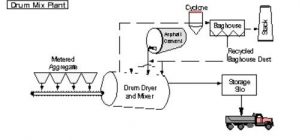How Does An Asphalt Plant Work?
There are 2 basic types of asphalt plants in use today, batching asphalt plants and continuous hot mix plants.
The working flow shows a contrast due to the different components involved.
Let’s explore how does each type of plant work?
How Does a Drum Mixing Plant Work?
 Step 1: Feeding
Step 1: Feeding
The drum asphalt mixing plant starts from the stockpiles. Each stockpile treats with a kind of aggregates in a certain size.
These materials are fed into the different cold aggregate hopper separately, depending on the their types and sizes.
The hopper helps regulate the flow of aggregates and the conveying belt controls the speed of aggregate transfer to the rotary drum.
Step 2: Drying and Mixing
The rotary drum is powered by a gas burner or a coal burner which is located at the middle of the drum.
In the first section of the drum, the burner radiates hot air to keep it contact with the aggregates in order to get them fully heated.
After dried, these aggregates flow to the second chamber of the drum to get mixed with asphalt cement and mineral filler material.
Step 3: Transporting/Storing
Once the hot asphalt mixture is blended thoroughly, they are stored in the finished products storage silo or wait for transport to the on-site.
- Check more information from the page – drum asphalt mixing plant.
How Does an Asphalt Batch Plant Work?

Step 1: Feeding
Similarly, the asphalt batching plant starts from feeding aggregates from the several stockpiles as well.
The aggregates in different size and various kinds are fed into the separate containers.
Through feeding belts and the tilted conveying belt, these cold aggregates in a certain ratio are transferred to the drum dryer in batches.
Step 2: Drying
The rotary drum is powered by a gas burner or a coal burner which is located at one of the end of the drum.
With adjustable parameters managed by the control panel, the temperature is directed to the best suited point.
The fuel feeder gives energy to the burner which releases hot flame to heat the aggregates completely.
Certainly, the dust and harmful gas produced during process are well collected by dust filter equipment.
Step 3: Screening
After dried, the hot aggregates lift to the vibrating screen via bucket elevator. Multiple motor helps the aggregates precisely classified through the different mesh layers.
Then, theses classified aggregates are stored in a hot receptacle with 4-6 separate cabinets respectively, waiting for metering.
During this time, the heat conducting oil system helps keep these aggregates warm for a few hours.
Step 4: Weighing
The mineral filling material from the filler silo and asphalt cement from the bitumen tanks are transferred into the weighing hopper.
These material are weighed as the required proportion (LUTON weighing system decreases the error within 0.05%).
Step 5: Mixing
When the aggregates, fine particles and bitumen are accurately weighed and flow to the mixer in specified ratio, the pugmill begins stirring.
Step 6: Transporting and Storing
Anyway, the batching asphalt plant is always fitted with a larger output. The dumper truck is unable to load such a large volume of finished products.
Therefore, in the large batch asphalt plant, there may be equipped with several storage bins.
If you have a small asphalt batching plant, mounting with a storage bin is enough.
There is a video for better understanding:
